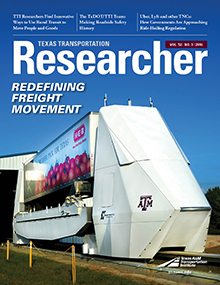As legend has it, Southwest Airlines started with an idea sketched on the back of a napkin. And from that humble drawing grew an idea that redefined air travel.
About 30 years later, Texas A&M Transportation Institute (TTI) Senior Research Scientist Steve Roop started with his own blank sheet of paper, in search of a better way to move cargo. And from his first sketch has grown an idea that’s now a big step closer to redefining freight movement.
Along the way, he has faced more than his share of skeptics. Far more. But as the inventor of the autonomous Freight Shuttle System (FSS), Roop has proven that just because naysayers hold that something is too good to be true, that doesn’t mean it is.
That proof was realized on September 9 at the FSS test and evaluation site, where Texas Gov. Greg Abbott, with the click of a computer mouse, set the 70,000-pound Freight Shuttle System in motion for its first public demonstration. Abbott praised the partnership of university research and industry investment that made it possible.
“I would suggest that Texas A&M is the model for how universities are so much more than just a place where students go to learn,” he said. “They are laboratories where advancements are made that improve our state and literally alter the arc of America.”

The first commercial example of that transformation could be under way soon at the Port of Houston Authority (PHA), where increased container traffic will continue to grow given the expansion of the Panama Canal. PHA Executive Director Roger Guenther and Roop, representing Freight Shuttle International, LLC (FSI), signed a formal agreement days before the demonstration to work together to evaluate options for deployment of the FSS at the port.
Guenther described his first introduction to the FSS concept years ago as “a very neat animation of these things moving up and down the track,” to eventually seeing a tangible working prototype. “It has transformed from this great idea to something that is really quite real,” Guenther said. “The demonstration you’ll see today of this working Freight Shuttle prototype confirms that it’s time to take the next step and dig deeper into these opportunities for deployment.”
The FSS operates on its own guideway using individual, autonomous transporters carrying truck trailers or shipping containers, powered by linear-induction electric motors. It borrows the best characteristics from both truck and rail transport, and uses only about one-third the energy required by diesel trucks.
Abbott and Guenther were joined by Texas A&M University System Chancellor John Sharp, who emphasized the A&M System’s commitment to public-private ventures.

“Great research universities are the economic drivers of the future,” Sharp said. “They have the ability to improve lives and create new industries and new companies.”
TTI Agency Director Dennis Christiansen, who’s overseen the FSS development in his 10-year tenure at the Institute, applauded the FSS research team for its innovative effort.
“The FSS is the result of more than a decade of research at TTI,” Christiansen said. “The team’s work has produced 17 patents held jointly by the A&M System and FSI.”
The FSS is being introduced at a time when the freight industry faces mounting challenges — strained rail and roadway system capacity, environmental concerns and a chronic shortage of truck drivers, to name only a few.
“There’s really no better place than the Texas A&M Transportation Institute to begin and execute work like this because this Institute has the nation’s best talent,” Roop said. “TTI supported this from an embryonic idea through the concept, and now product development.”
Beginning with that very first sketch, Roop was driven by a passion and a belief.
“From the outset,” he says, “I thought this could work.”


